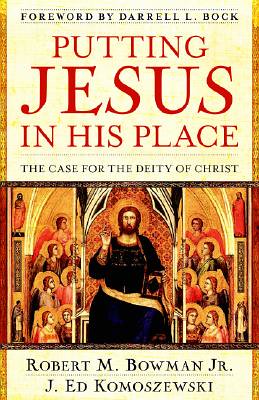 The New Testament presents Jesus as divine--and in more than a couple of proof texts. The concept is the warp and woof of the entire New Testament tapestry.
The New Testament presents Jesus as divine--and in more than a couple of proof texts. The concept is the warp and woof of the entire New Testament tapestry.
Robert M. Bowman Jr. and J. Ed Komoszewski serve the church well by highlighting this truth in their book, Putting Jesus in His Place: The Case for the Deity of Christ.
The book is designed for wide popular audience, and the authors use an acronym, H.A.N.D.S. as a memory device to group the case for Christ's divinity into five categories. The acronym recalls the experience of Thomas in John 20:24-29. When the doubting apostle saw the marks in Jesus' hands left by the nails of the crucifixion, he fell at Christ's feet exclaiming, "my Lord and my God!" "Just as an examination of the nail prints convinced Thomas he was beholding the hands of deity," the authors say, "a closer look at the Bible reveals that Jesus shares the HANDS of God:
- Honors: Jesus shares the honors due to God
- Attributes: Jesus shares the attributes of God
- Names: Jesus shares the names of God
- Deeds: Jesus shares in the deeds that God does
- Seat: Jesus shares the seat of God's throne
It's a helpful book, and I recommend it with certain qualifications (below). The acronym will likely show up in my teaching on this subject, and it's a good resource to show people that the idea of Christ's divinity is found throughout the New Testament and not simply in a few isolated claims. The authors make good use of scholarly resources and the book is well footnoted.
I do think the authors could have included a chapter defending the early dating of the New Testament documents. This is where the battle lies today: in the end, there is a certain futility in patiently explaining to people that the New Testament presents a divine Jesus if people have it in their heads that the New Testament was written long after Jesus lived.
I also think that the authors could have included a chapter answering the "so what" question. What difference does it make to accept the claim that Jesus was divine? The longer that pastors and professors spend discussing these things, the more "obvious" the implications seems to us--and thus the more likely we are to leave them out of our discussions. I tried to address the "so what" question in my book for seekers, The Anchor Course, and so I always notice when this question is left alone in so many treatments of Christian truth.
There's a third qualification I make to my endorsement of the book. I cringed over the authors' efforts to be "cute" in the use of pop references to explain Christ. Start with the book's title: Does one really want to "put Jesus in his place"--a reference in our culture to putting someone down? Is it because God "cared enough to send the very best" that Jesus came (85; a reference to an old, old Hallmark commercial)? Is it best to refer to Jesus as "God's right hand man" (243) who keeps "going and going and going" (195; like the Energizer bunny) because he has "the right stuff" (103; like a 60s astronaut)? Should we celebrate because "he's got the power" (198; a reference to a getting-older-by-the-year pop tune) and is now in his exaltation "on top of the world!" (255; a reference to a really old pop tune). Christ's eternal nature is discussed under the heading "Older Than Dirt--Literally!" (99) and his return is covered under the heading "Here Comes the Judge!" And, really, am I more likely to pray to Jesus because he is the answer to the question "Who Ya Gonna Call?" (49; yes, as in "Ghostbusters")?
Come to think of it, I'm not sure if the crime is using some really cheesy and easy pop references, or in using some really old cheesy and easy pop references. At any rate, the relentless "cute" phrases were a distraction. I'm guessing it was in an effort to make an academic discussion more accessible to a lay audience, but it lowered the treatment of such an exalted subject.
Beyond these observations, though, its never a bad thing to spend time in a book that reminds you of who Jesus really was. And is.
No comments:
Post a Comment